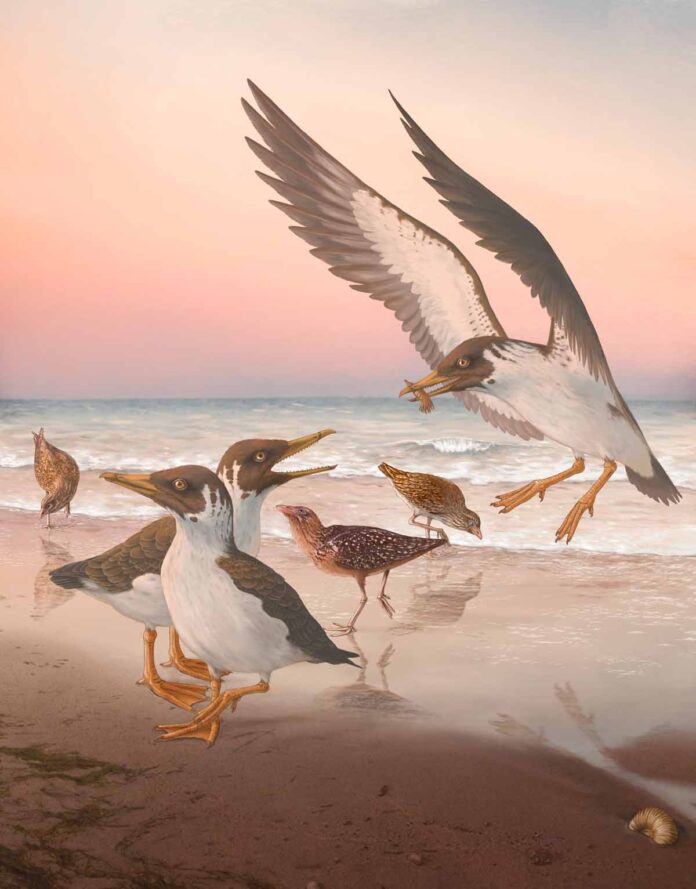According to researchers, a skeleton fossil discovered in a grapefruit-sized rock has helped to disprove more than a century of knowledge about the origins of modern birds.
A new study discovered that one of the key skull features that distinguishes 99% of modern birds which is a mobile beak, evolved prior to the 66 million-year-old mass extinction event that wiped out all large dinosaurs.
This discovery also implies that the skulls of ostriches, emus, and their relatives evolved “backwards”. It reverted to a more primitive state after modern birds evolved.
Scientists used CT scanning techniques to identify bones from the palate, or roof of the mouth, of a new species of large ancient bird named Janavis finalidens. It was one of the last toothed birds to exist at the end of the Age of Dinosaurs. The arrangement of its palate bones indicates that this “dino-bird” had a mobile, dexterous beak. This beak was nearly identical to that of most modern birds.
Based on the arrangement of their palate bones, each of the approximately 11,000 species of birds on the planet today is classified into one of two overarching groups. Ostriches, emus, and their relatives are classified as palaeognaths, or “ancient jaws”. Because their palate bones are fused together into a solid mass, similar to humans.
All other groups of birds are classified as neognaths, or “modern jaws.” Because their palate bones are joined by a mobile joint. This increases the dexterity of their beaks, which is useful for nest-building, grooming, food gathering, and defence.
Thomas Huxley, the British biologist known as “Darwin’s Bulldog” first classified the two groups. In 1867, he classified all living birds into “ancient” or “modern” jaw groups. Huxley assumed that the “ancient” jaw configuration was the original state of modern birds, with the “modern” jaw emerging later.
Janavis was discovered in a limestone quarry near the Belgian-Dutch border in the 1990s. It was studied for the first time in 2002 and was created 66.7 million years ago, during the time of the dinosaurs. The fossil was encased in rock. So, scientists at the time could only describe what they could see from the outside. They identified the bone fragments sticking out of the rock as skull and shoulder bones. Then returned the unremarkable-looking fossil to storage.
The fossil was loaned to Field’s group in Cambridge nearly 20 years later. And Dr. Juan Benito, then a Ph.D. student, began looking at it again.
Benito took the fossil out again during the early days of COVID-19 lockdown. “The earlier descriptions of the fossil simply didn’t make sense. There was one bone in particular that puzzled me. I couldn’t believe what was initially described as a shoulder bone could possibly be a shoulder bone “He stated.
The discovery that the bone was a skull bone rather than a shoulder bone led the researchers to the conclusion. The conclusion was that the unfused “modern jaw” condition shared by turkeys evolved before the “ancient jaw” condition shared by ostriches and their relatives. For unknown reasons, the fused palates of ostriches and their relatives must have evolved after modern birds were already established.
A toothless beak and a mobile upper jaw are two key characteristics that distinguish modern birds from their dinosaur ancestors. While Janavis finalidens still had teeth, making it a pre-modern bird, its jaw structure is modern and mobile.
According to the researchers, this discovery does not require a redrawing of the entire bird family tree. But it does rewrite our understanding of a key evolutionary feature of modern birds.
And what became of Janavis? It, like the large dinosaurs and other toothed birds, perished during the Cretaceous period’s mass extinction. According to the researchers, this could be due to its large size. Janavis was about the size of a modern vulture and weighed about 1.5 kilogrammes.

